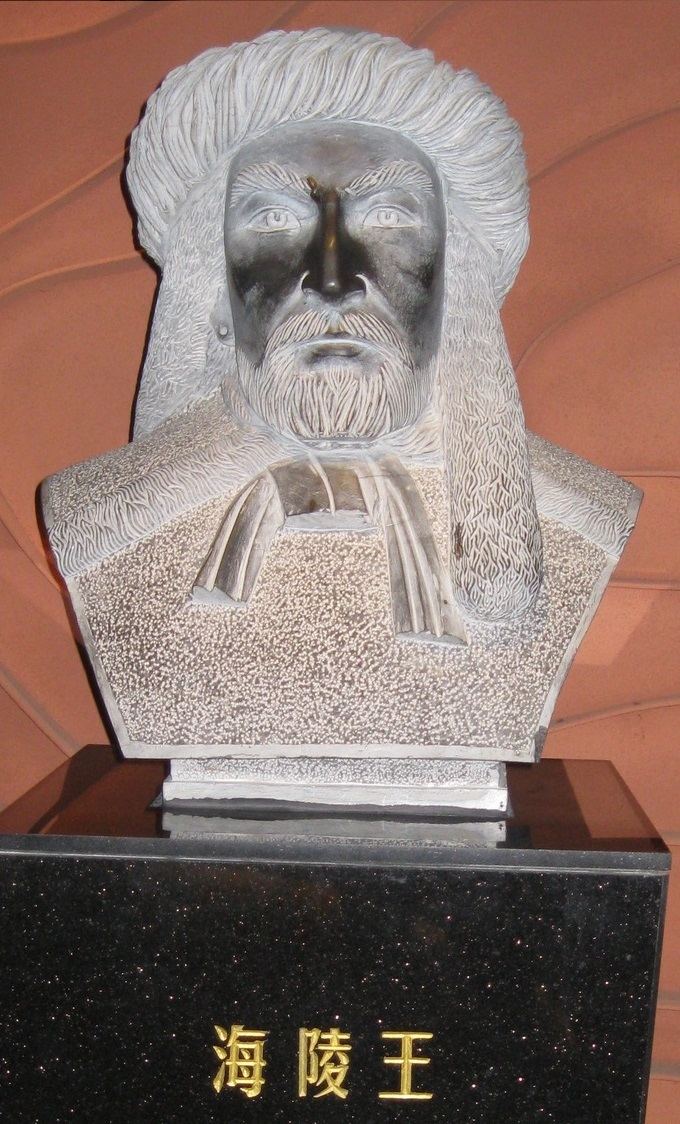Name Prince of Grandparents Emperor Taizu of Jin | Died 1161, China Royal line Jin dynasty | |
 | ||
Reign January 9, 1150 – December 15, 1161 Father Wanyan Woben 完顏斡本 (posthumously honored as Emperor Dezong, 1162 deprived by Shizong) Mother Lady Da 大氏 (posthumously honored as Empress Cixian, 1162 deprived by Shizong) Children Wanyan Guangying, Wanyan Yuanshou Parents Empress Cixian, Wanyan Zonggan Great-grandparents Empress Yijian, Wanyan Helibo | ||
Hailing Wang (Chinese: 海陵王; literally: "Prince of Hailing") (February 24, 1122 – December 15, 1161) was emperor of the Jin Dynasty, the Jurchen dynasty which ruled northern China. He reigned from January 9, 1150 until December 15, 1161. His birth name was Wanyan Liang (完顏亮), or in Jurchen, Digunai (迪古乃). He promoted the policy of sinicization of Jurchens, which was partially reversed by his successor, Emperor Shizong of Jin.
Contents
Background
Wanyan Liang was a son of Wanyan Woben, who in his turn was a son of the dynasty's founder Wanyan Aguda. Aguda's successor Wuqimai initiated the Jurchen war against the Song Dynasty, a conflict that continued during Liang's reign. Liang's father, Woben, was described as the most influential man during the reign of Liang's predecessor, Wanyan Dan.
Wanyan Liang, himself a marshal under Wanyan Dan, killed the emperor and usurped the throne in 1149. As a usurper of the Jin throne, Hailing was suspicious of other members of the Jurchen aristocracy, and, immediately upon seizing the power, started assassinating or executing potential rivals. In a mass execution of several aristocratic families, the lineage of Wanyan Wuqimai was exterminated, to secure the position of the lineage of Wuqimai's brother Aguda, to which Hailing himself belonged.
Reign
Capitalizing on the Jin Empire's being recognized as the "superior" state by other powers of the region after its victory over Song had been formalized in 1141, Hailing embarked on a program of making Jin Empire the Chinese Empire. To legitimize himself as a Chinese ruler, he lifted (1150) Wuqimai's prohibition of wearing Chinese dress, and adopted an array of Chinese practices and institutions, such as holding of sacrificial ceremonies in the northern and southern suburbs of his capital (1149) (cf. ceremonies conducted at the Temple of Earth and Temple of Heaven in Beijing under Ming and Qing), the use of the imperial carriage (1151), a system of feudal rights (1156), and the Song's shan-hu (山呼) style of court ceremonies (1157). Hailing introduced palace examinations (1150) and set up the Imperial Academy (Guozijian) in 1151. In his pursuit to become the "real Chinese", entitled to rule all over the Heavenly Kingdom, Hailing moved his court from the original Jurchen capital, Huining to Yanjing (modern Beijing) in 1153, and later on (1157) ordered the destruction of the palaces in Huining.
In contrast to China's Tang and Song traditions, which rarely imposed corporal punishment on the members of the society's educated elites, Hailing continued the Khitan and Jurchen tradition of floggings with a gusto, sometimes enjoying personally watching his officials and court members – including prime ministers, censors, and a princess – beaten with poles or whips.
War and assassination
Hailing's attempts to conquer the Southern Song and unify China under his rule ended in failure, his fleet defeated by the Song (1161) at Tangdao and Caishi, many of his officers defecting, and the population rebelling in some areas. His officers conspired against him, and the emperor was assassinated on 15 December 1161 in a military camp near the Yangtze River front. Hailing's cousin Wanyan Wulu, who had led a major rebellion against him, was proclaimed the new ruler.
Reign periods
- Tiande 天德 1149–1153
- Zhenyuan 貞元 1153–1156
- Zhenglong 正隆 1156–1161
